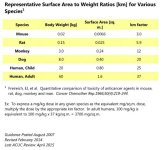The chart above is not based on sound science and is not reliable.
The BSA method for determining animal to human dosage conversion has many flaws, and as the following article states, "Although BSA conversion equations have been used in certain clinical applications for decades, recent recommendations to use BSA to derive interspecies equivalents for therapeutic dosages of drug and natural products are inappropriate."
Translating dosages from animal models to human clinical trials?revisiting body surface area scaling
Translating dosages from animal models to human clinical trials—revisiting body surface area scaling
Otis L. Blanchard* and James M. Smoliga†,‡,1
+
Author Affiliations
*Wilmore Labs Limited Liability Company, San Antonio, Texas, USA; and †Department of Physical Therapy, School of Health Sciences, and ‡Department of Basic Pharmaceutical Sciences, School of Pharmacy, High Point University, High Point, North Carolina, USA
↵1Correspondence: Department of Physical Therapy, School of Health Sciences, High Point University, 833 Montlieu Ave., High Point, NC 27409, USA. E-mail:
[email protected]
Next Section
Abstract
Body surface area (BSA) scaling has been used for prescribing individualized dosages of various drugs and has also been recommended by the U.S. Food and Drug Administration as one method for using data from animal model species to establish safe starting dosages for first-in-human clinical trials. Although BSA conversion equations have been used in certain clinical applications for decades, recent recommendations to use BSA to derive interspecies equivalents for therapeutic dosages of drug and natural products are inappropriate. A thorough review of the literature reveals that BSA conversions are based on antiquated science and have little justification in current translational medicine compared to more advanced allometric and physiologically based pharmacokinetic modeling. Misunderstood and misinterpreted use of BSA conversions may have disastrous consequences, including underdosing leading to abandonment of potentially efficacious investigational drugs, and unexpected deadly adverse events. We aim to demonstrate that recent recommendations for BSA are not appropriate for animal-to-human dosage conversions and use pharmacokinetic data from resveratrol studies to demonstrate how confusion between the “human equivalent dose” and “pharmacologically active dose” can lead to inappropriate dose recommendations. To optimize drug development, future recommendations for interspecies scaling must be scientifically justified using physiologic, pharmacokinetic, and toxicology data rather than simple BSA conversion.—Blanchard, O. L., Smoliga, J. M. Translating dosages from animal models to human clinical trials—revisiting body surface area scaling.


































.gif)











































